Standards Worldwide
Standards Worldwide
Phone +49 30 58885700-07

Standard [CURRENT]
ASTM E 3361:2022
Standard Guide for Estimating Natural Attenuation Rates for Non-Aqueous Phase Liquids in the Subsurface
- Publication date
- 2022
- Original language
- English
- Pages
- 47
- Publication date
- 2022
- Original language
- English
- Pages
- 47
- DOI
- https://dx.doi.org/10.1520/E3361-22
Product information on this site:
Quick delivery via download or delivery service
Buy securely with a credit card or pay upon receipt of invoice
All transactions are encrypted
Short description
1.1 This is a guide for determining the appropriate method or combination of methods for the estimation of natural attenuation or depletion rates at sites with non-aqueous phase liquid (NAPL) contamination in the subsurface. This guide builds on a number of existing guidance documents worldwide and incorporates the advances in methods for estimating the natural attenuation rates. 1.2 The guide is focused on hydrocarbon chemicals of concern (COCs) that include petroleum hydrocarbons derived from crude oil (for example, motor fuels, jet oils, lubricants, petroleum solvents, and used oils) and other hydrocarbon NAPLs (for example, creosote and coal tars). While much of what is discussed may be relevant to other organic chemicals, the applicability of the standard to other NAPLs, like chlorinated solvents or polychlorinated biphenyls (PCBs), is not included in this guide. 1.3 This guide is intended to evaluate the role of NAPL natural attenuation towards reaching the remedial objectives and/or performance goals at a specific site; and the selection of an appropriate remedy, including remediation through monitoring of natural or enhanced attenuation, or the remedy transition to natural mechanisms. While the evaluation can support some aspects of site characterization, the development of the conceptual site model and risk assessment, it is not intended to replace risk assessment and mitigation, such as addressing potential impact to human health or environment, or need for source control. 1.4 Estimation of NAPL natural attenuation rates in the subsurface relies on indirect measurements of environmental indicators and their variation in time and space. Available methods described in this standard are based on evaluation of biogeochemical reactions and physical transport processes combined with data analysis to infer and quantify the natural attenuation rates for NAPL present in the vadose and/or saturated zones. 1.5 The rate estimates can be used for developing metrics in the corrective action decision framework, complementing the LNAPL Conceptual Site Model (LCSM) (Guide E2531 ). 1.6 The emphasis in this guide is on the selection and application of methods for quantifying rates of NAPL depletion or attenuation. It is assumed that the remediation endpoint has been defined for the site based on the remedial objectives to address composition or saturation concerns as defined in ITRC (2018) ( 1 ) . 2 While the rates can be used to estimate the timeframe to reach the remediation endpoint under natural conditions, methods for estimating the total NAPL mass and timeframe are beyond the scope of this standard. 1.7 The users of this guide should be aware of the appropriate regulatory requirements that apply to sites where NAPL is present or suspected to occur. The user should consult applicable regulatory agency requirements to identify appropriate technical decision criteria and seek regulatory approvals, as necessary. 1.8 ASTM standard guides are not regulations; they are consensus standard guides that may be followed voluntarily to support applicable regulatory requirements. This guide may be used in conjunction with other ASTM guides developed for sites with NAPL in the subsurface. The guide supplements characterization and remedial efforts performed under international, federal, state, and local environmental programs, but it does not replace regulatory agency requirements. 1.9 SI units are primarily used in the standard, however, units more commonly used in the industry are also represented. 1.10 The guide is organized as follows: 1.10.1 Section 2 lists referenced documents. 1.10.2 Section 3 defines terminology used in this guide. 1.10.3 Section 4 describes the significance and use of this guide. 1.10.4 Section 5 provides the conceptual model of natural attenuation processes and pathways. 1.10.5 Section 6 provides an overview and description of methods for the estimation of natural attenuation rates, including: 1.10.5.1 Description of methods and available technologies: (1) CO 2 efflux method (2) Temperature gradient method (3) Soil gas gradient method (4) Groundwater monitoring method (5) NAPL composition method 1.10.5.2 Screening or feasibility assessment of the method for the site conditions; 1.10.5.3 Background sources and correction methods; 1.10.5.4 Data interpretation, key considerations and challenges (for example, measurement frequency and locations and spatial/temporal averaging); 1.10.5.5 Applicability of methods for evaluating the performance of enhanced natural attenuation (bioremediation) systems; 1.10.5.6 Other method applications (for example, source delineation or estimating mass discharge rates). 1.10.6 Section 7 provides guidance on selection of a method or combination of methods applicable to site-specific conditions. 1.10.7 Section 8 provides example applications through case studies. 1.10.8 Section 9 lists keywords relevant to this guide. 1.10.9 Appendix X1 describes details of the CO 2 Efflux Method. 1.10.10 Appendix X2 describes details of the Temperature Gradient Method. 1.10.11 Appendix X3 describes details of the Soil Gas Gradient Method. 1.10.12 Appendix X4 describes details of the Groundwater Monitoring Method. 1.10.13 Appendix X5 describes details of the NAPL Composition Method. 1.10.14 Appendix X6 provides details of case studies discussed in Section 8 . 1.10.15 Appendix X7 provides example estimates of NAPL quantity. 1.11 This standard does not purport to address all of the safety concerns, if any, associated with its use. It is the responsibility of the user of this standard to establish appropriate safety, health, and environmental practices and determine the applicability of regulatory limitations prior to use. 1.12 This international standard was developed in accordance with internationally recognized principles on standardization established in the Decision on Principles for the Development of International Standards, Guides and Recommendations issued by the World Trade Organization Technical Barriers to Trade (TBT) Committee.
ICS
13.080.05
DOI
https://dx.doi.org/10.1520/E3361-22
Loading recommended items...
Loading recommended items...
Loading recommended items...
Loading recommended items...
